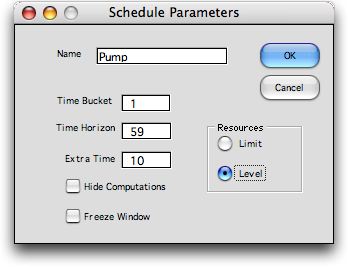For this model
we choose the Level button in the schedule dialog.

For
the level model we want to minimize the variation of resource
usage about the amount of the resource available. The objective
reflects the goal of having a uniform amount of the resource
used during the life of the project without great variations
above or below the amounts available in the different periods.
The mathematical development is below. The variation of the
resource depends on the schedule through the x variables
and the amount of variation is represented by the s
variables. The variation in any one period may be positive or
negative, but the squared value used in the evaluation is always
positive. As for the limit model, the amounts available (R)
may vary over the periods in T. Although we allow the
cost of variation (c) to vary over time and resource,
for most cases it would be appropriate to use 1 for all values.
An interesting observation occurs if we say that the amount
of the resource is constant over time. In the following we assume
all variation costs are 1 and that the resource available (R)
does not vary with time. We expand the squared term
In the final expression for the cost of variation
we identify two terms using the large brackets. The first is
a constant that does not depend on the schedule. The second
term does depend on the schedule and is the sum of the squares
of resource usage over time. For optimization, any constant
term can be neglected without affecting the optimum solution,
so the optimum only depends on the sum of the squares of resource
usage. The values used for resource availabilities (R)
do not affect the optimum solution when the goal is to minimize
the cost of variation.
This result is not true if the resource availability
changes over time. The analysis also depends (in the second
line from the bottom) on the fact that the total time required
for each activity, and thus the total resource required, does
not depend on the schedule. This is not true if some of the
activities using resources are variable
time activities.
The analysis also assumes that the time required
for the project (T) is constant and does not depend
on the schedule. This is not true if the optimization allows
the total time to change with the schedule. If we allow the
time to change, it may be possible to reduce the sum of the
squares by spreading out the project into more periods. This
may or may not reduce the total variability or the average
variability in time. We do not adjust the analysis for this
because it is unlikely that the project duration will be
allowed to extend many periods beyond the due date. The resultant
approximation is small.
When variability is more important for one resource
than another, the cost parameters (c) many be different
for different resources. This does not change these results
unless the costs vary over time.
The figure below shows the Gantt chart when variance
is the measure to be minimized. Rows 31 and 32 show the amount
used and available in each period. Row 33 shows the difference
between the amount used and the amount available squared. The
variance cost is evaluated in row 35. Since the unit cost is
1, rows 33 and 35 are the same. When there is more than one
resource, rows are provided for each. |



